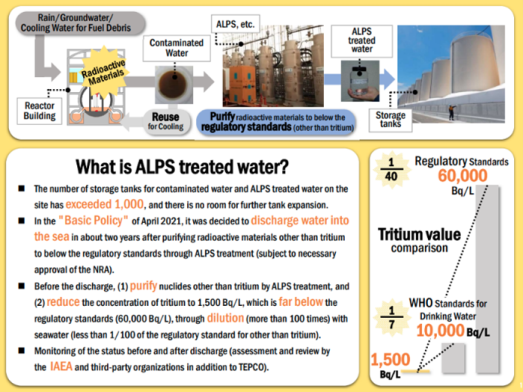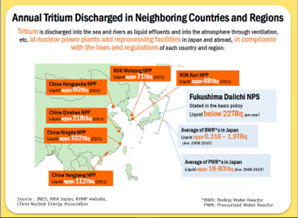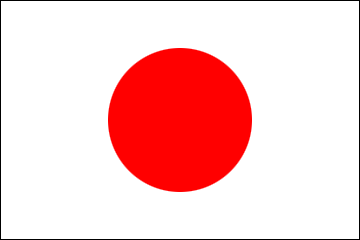Let the Science Talk: the Safety of ALPS Treated Water in Fukushima
2024/1/9
Having read about the Senate Joint Resolution No. 11-43 expressing “the disapproval and disappointment” on the release of the treated water at Tokyo Electric Power Company (TEPCO)’s Fukushima Daiichi Nuclear Power Station (FDNPS), I would like to take a moment again to provide science-based explanation on Japan’s efforts on this matter.
First, the water being discharged into the sea has been purified until the concentration of all radioactive materials (including cesium-137 and strontium-90) other than tritium is far below the regulatory standard set based on international standards, and this water is further diluted so that the tritium concentration level is less than about 1/7 of the WHO drinking water standard, ensuring safety.

Tritium is similar to hydrogen, widely present in rainwater, seawater, tap water and human body. Tritium emits very weak radiation, but only to the extent that a sheet of paper can prevent it. Tritium is not accumulated in human body and is excreted with water.
With the advice of international experts from 11 countries (Argentina, Australia, Canada, China, France, the Marshall Islands, the Republic of Korea the Russian Federation, the United Kingdom, the United States and Viet Nam), the International Atomic Energy Agency (IAEA) has concluded in its Comprehensive Report in July 2023 that (i) the approach to the discharge of ALPS treated water into the sea and the associated activities are consistent with relevant international safety standards, and (ii) the radiological impact on humans and the environment will be negligible.
Building on all those scientific findings, Japan has thoroughly explained its efforts in good faith through international conferences and bilateral meetings as well as dedicated briefings to the Pacific Islands countries. The understanding on Japan’s efforts is expanding, as countries in a wide range of regions, including Pacific, Asia, Europe, and Latin America, have expressed their understanding and support for Japan and the IAEA.
As of now, the 1st batch of the ALPS treated water discharge was conducted from August 24 to September 11, 2023, the 2nd batch was conducted from October 5 to October 23, 2023, and the latest 3rd batch was conducted from November 2 to 20, 2023. The upcoming 4th discharge will be scheduled to be on late February 2024, which will be the final for FY 2023, being part of a series of discharges that have already begun.
The Government of Japan and TEPCO has been conducting multi-layered monitoring, with the involvement of the IAEA. All of ALPS treated water to be discharged is measured and evaluated prior to each discharge to confirm that the level of radioactive materials is far below the regulatory standard, and the results of such measurement and evaluation are publicized prior to each discharge. The monitoring to date has confirmed that the discharge has been conducted safely as planned. On 11 December, the IAEA released a report on the results of the Interlaboratory Comparisons, which has been conducted among the IAEA, Japanese laboratories and third-country laboratories from Finland and the Republic of Korea, stating that Japan's sample collection procedures were appropriate and that a continued high level of accuracy and competence on the part of Japanese laboratories involved in the analyses of radionuclides in marine samples as part of the Sea Area Monitoring was demonstrated.
Thus, the discharge never affects human health, the Pacific Ocean as our common asset and our future. Many people, including Prime Minister Kishida and officials in the diplomatic corps in Tokyo, are engaged in activities to support Fukushima by eating local seafood.
For the enhancement of further transparency, independent third-party laboratories from China, South Korea and Canada also visited Japan from 16 to 23 October 2023 and collected seawater and marine sediment in the vicinity of TEPCO’s FDNPS, and fishery products in Fukushima Prefecture, as part of IAEA marine monitoring to ensure reliability and transparency of the Sea Area Monitoring in Japan.

Video posted on “X” on September 5, 2023 by H.E. Justin Hayhurst, Australian Ambassador to Japan
Furthermore, it is worth noting that the discharge of treated water into the sea is a common practice for nuclear power plants globally. Japan is strictly controlling the total amount of annual tritium to be discharged to ensure that it is below the control target for tritium discharge at the FDNPS before the accident by Great East Japan Earthquake in 2011. The total amount of annual tritium to be discharged is smaller than the total amount of tritium discharged from nuclear facilities in other countries, so that neither the Pacific Ocean nor Palau is endangered. Therefore, it is unscientific and unfair to focus only on the case of Fukushima Daiichi Nuclear Power Station and point out its safety.

Japan remains fully committed to providing information based on scientific evidence in a highly transparent and timely manner for the people of Palau and firmly opposed to dissemination of factually and scientifically inaccurate claims. Let the science talk.
Ambassador of Japan to Palau, ORIKASA Hiroyuki
First, the water being discharged into the sea has been purified until the concentration of all radioactive materials (including cesium-137 and strontium-90) other than tritium is far below the regulatory standard set based on international standards, and this water is further diluted so that the tritium concentration level is less than about 1/7 of the WHO drinking water standard, ensuring safety.

Tritium is similar to hydrogen, widely present in rainwater, seawater, tap water and human body. Tritium emits very weak radiation, but only to the extent that a sheet of paper can prevent it. Tritium is not accumulated in human body and is excreted with water.
With the advice of international experts from 11 countries (Argentina, Australia, Canada, China, France, the Marshall Islands, the Republic of Korea the Russian Federation, the United Kingdom, the United States and Viet Nam), the International Atomic Energy Agency (IAEA) has concluded in its Comprehensive Report in July 2023 that (i) the approach to the discharge of ALPS treated water into the sea and the associated activities are consistent with relevant international safety standards, and (ii) the radiological impact on humans and the environment will be negligible.
Building on all those scientific findings, Japan has thoroughly explained its efforts in good faith through international conferences and bilateral meetings as well as dedicated briefings to the Pacific Islands countries. The understanding on Japan’s efforts is expanding, as countries in a wide range of regions, including Pacific, Asia, Europe, and Latin America, have expressed their understanding and support for Japan and the IAEA.
As of now, the 1st batch of the ALPS treated water discharge was conducted from August 24 to September 11, 2023, the 2nd batch was conducted from October 5 to October 23, 2023, and the latest 3rd batch was conducted from November 2 to 20, 2023. The upcoming 4th discharge will be scheduled to be on late February 2024, which will be the final for FY 2023, being part of a series of discharges that have already begun.
The Government of Japan and TEPCO has been conducting multi-layered monitoring, with the involvement of the IAEA. All of ALPS treated water to be discharged is measured and evaluated prior to each discharge to confirm that the level of radioactive materials is far below the regulatory standard, and the results of such measurement and evaluation are publicized prior to each discharge. The monitoring to date has confirmed that the discharge has been conducted safely as planned. On 11 December, the IAEA released a report on the results of the Interlaboratory Comparisons, which has been conducted among the IAEA, Japanese laboratories and third-country laboratories from Finland and the Republic of Korea, stating that Japan's sample collection procedures were appropriate and that a continued high level of accuracy and competence on the part of Japanese laboratories involved in the analyses of radionuclides in marine samples as part of the Sea Area Monitoring was demonstrated.
Thus, the discharge never affects human health, the Pacific Ocean as our common asset and our future. Many people, including Prime Minister Kishida and officials in the diplomatic corps in Tokyo, are engaged in activities to support Fukushima by eating local seafood.
For the enhancement of further transparency, independent third-party laboratories from China, South Korea and Canada also visited Japan from 16 to 23 October 2023 and collected seawater and marine sediment in the vicinity of TEPCO’s FDNPS, and fishery products in Fukushima Prefecture, as part of IAEA marine monitoring to ensure reliability and transparency of the Sea Area Monitoring in Japan.

Video posted on “X” on September 5, 2023 by H.E. Justin Hayhurst, Australian Ambassador to Japan
Furthermore, it is worth noting that the discharge of treated water into the sea is a common practice for nuclear power plants globally. Japan is strictly controlling the total amount of annual tritium to be discharged to ensure that it is below the control target for tritium discharge at the FDNPS before the accident by Great East Japan Earthquake in 2011. The total amount of annual tritium to be discharged is smaller than the total amount of tritium discharged from nuclear facilities in other countries, so that neither the Pacific Ocean nor Palau is endangered. Therefore, it is unscientific and unfair to focus only on the case of Fukushima Daiichi Nuclear Power Station and point out its safety.

Japan remains fully committed to providing information based on scientific evidence in a highly transparent and timely manner for the people of Palau and firmly opposed to dissemination of factually and scientifically inaccurate claims. Let the science talk.
Ambassador of Japan to Palau, ORIKASA Hiroyuki
